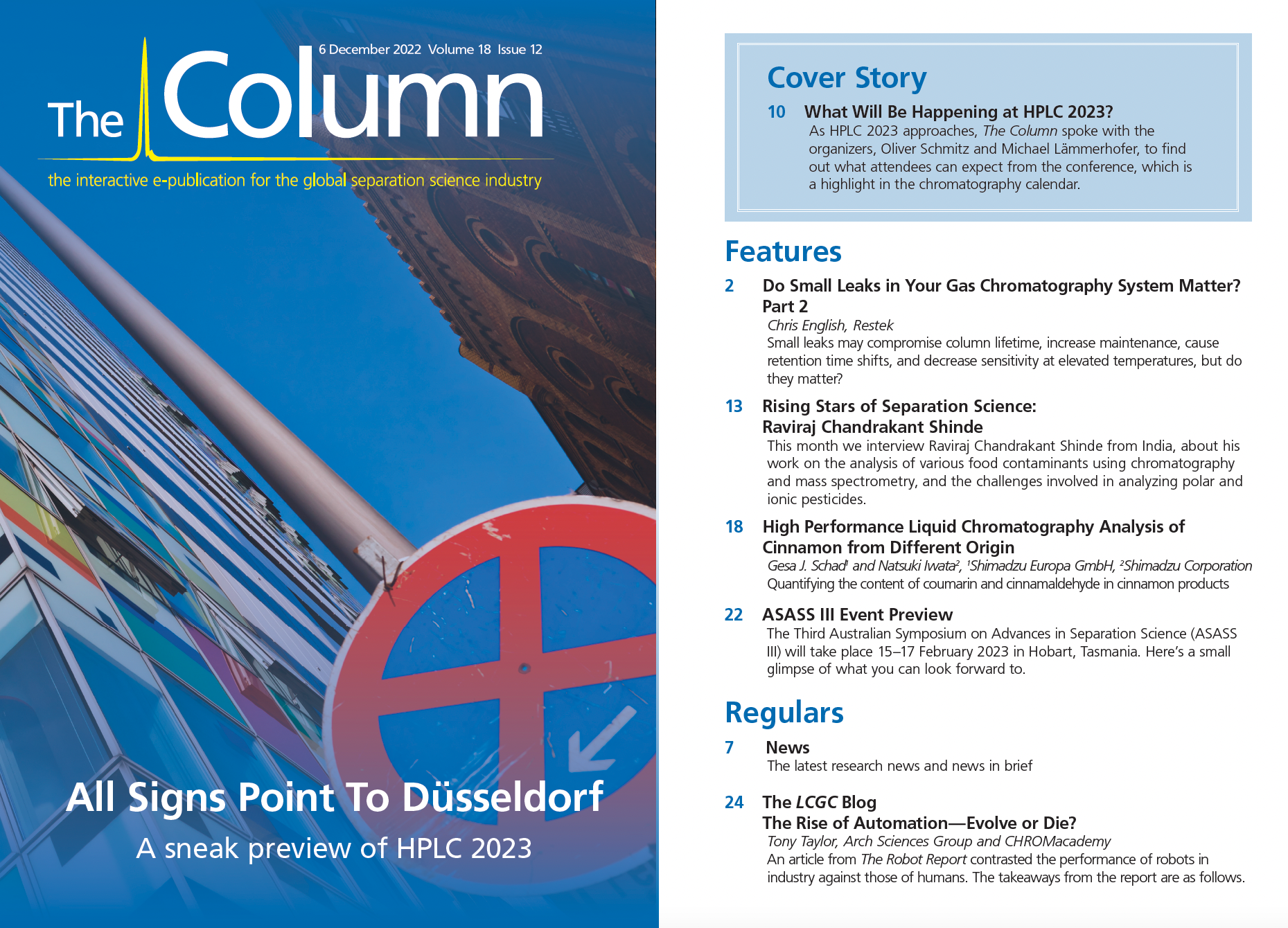Do Small Leaks in Your Gas Chromatography System Matter? Part 2
In the last instalment (1) we determined that a leak in the system that does not result in an injection port shutdown and allows the mass spectrometer to perform a tune can still result in loss of sensitivity and increased bleed at higher temperatures. For example, a “1-type” stationary phase exposed to 23% nitrogen (m/z 28) and 4% water (m/z 18) when compared with the tuning compound’s base peak of m/z 69 dramatically increased in bleed when operated at the column’s maximum temperature for 180 min. Analysis under USA these conditions suggests the column would be irrevocably damaged with continued exposure to temperature in the presence of air/water. In our last experiment, the “1701-type” column was installed but a consistent leak could not be maintained while at the maximum programmable temperature of 280 °C. This article will revisit the “1701‑type” column and evaluate an arylene-35% diphenyl column and demonstrate a way to test both columns with a consistent leak (Figure 1). Phases that contain arylene or silphenylene substituted into the siloxane backbone are more thermally stable since the polymer becomes less flexible (2), whereas cyano-groups are considered more sensitive to oxygen and water.
Experimental Design
Three stationary phases were evaluated: a “1-type” 100% polydimethylsiloxane (PDMS), a “1701-type” composed of 14% cyanopropyl-phenyl with the remaining 86% as PDMS, and an arylene-35% diphenyl with the remaining percentage as PDMS (all Restek). Column dimensions for the columns tested were 30 m × 0.25 mm, 0.25-μm and each column was installed into a gas chromatography–mass spectrometry (GC–MS) system (Agilent 7890 GC, 5975 MS) with a split/splitless inlet and 100:1 split, constant flow 0.5 mL/min (~1 psi @ 50 °C). The “1‑type” GC program was 50 °C (hold 10 min), 10 °C per min to 200 °C (hold 10 min), 10 °C per min to 250 °C (hold 10 min), 10 °C per min to 300 °C (hold 10 min), 10 °C per min to 350 °C (hold 10 min), as shown in Figures 2 and 3. The “1701‑type” GC program was 50 °C (hold 10 min), 10 °C per min to 200 °C (hold 10 min), 10 °C per min to 250 °C (hold 10 min), 10 °C per min to 280 °C (hold 10 min), as shown in Figure 4. The arylene-35% diphenyl column was 50 °C (hold 10 min), 10 °C per min to 200 °C (hold 10 min), 10 °C per min to 250 °C (hold 10 min), 10 °C per min to 300 °C (hold 10 min), 10 °C per min to 360 °C (hold 10 min), as shown in Figure 4.
The columns were operated to their maximum programmable temperature limits with and without leaks. A 1 m × 0.25 mm internal diameter guard column was installed in the split/splitless inlet connected to the analytical column using two press-fit connectors. The first press-fit connector was scratched along the side of the column to create a partial seal and the second press-fit connector was used to connect each column to the leaking press-fit. By maintaining the same leaking press-fit, each column could be evaluated with the same leak. Testing was performed without a leak and with a small leak. When evaluating the columns without a leak, the leaking press-fit and guard were carefully removed to be reinstalled for the next column evaluation. This allowed both the “1701‑type” and the arylene-35% diphenyl to be tested with the same leak, as shown in Figure 1. The leak was determined by measuring nitrogen (m/z 28) and water (m/z 18) and comparing with PFTBA’s base peak of m/z 69 to determine air and water relative to the abundance of the tuning compound and reported as percentages. A 1000 μg/mL pesticide standard of disulfoton, o,o,o-triethyl phosphorothioate, dimethoate, sulfotepp, methyl parathion, famphur, phorate, zinophos, and ethyl parathion dissolved in methylene chloride was used for this testing. The compounds have boiling points of between 200–400 °C and were monitored for response, retention, and peak shape to verify consistency between analyses and columns. The MS scan rate was m/z 35–550 without a solvent delay.
Figure 1: Two press-fit connectors were used where the first connector closest to the injection port was installed with a leak and the second connector allowed other columns to be connected maintaining the same leak for both the “1701-type” column and the arylene-35% diphenyl column. The guard column installed in the inlet with the leaking press-fit could be removed to generate data without leaks in the system.
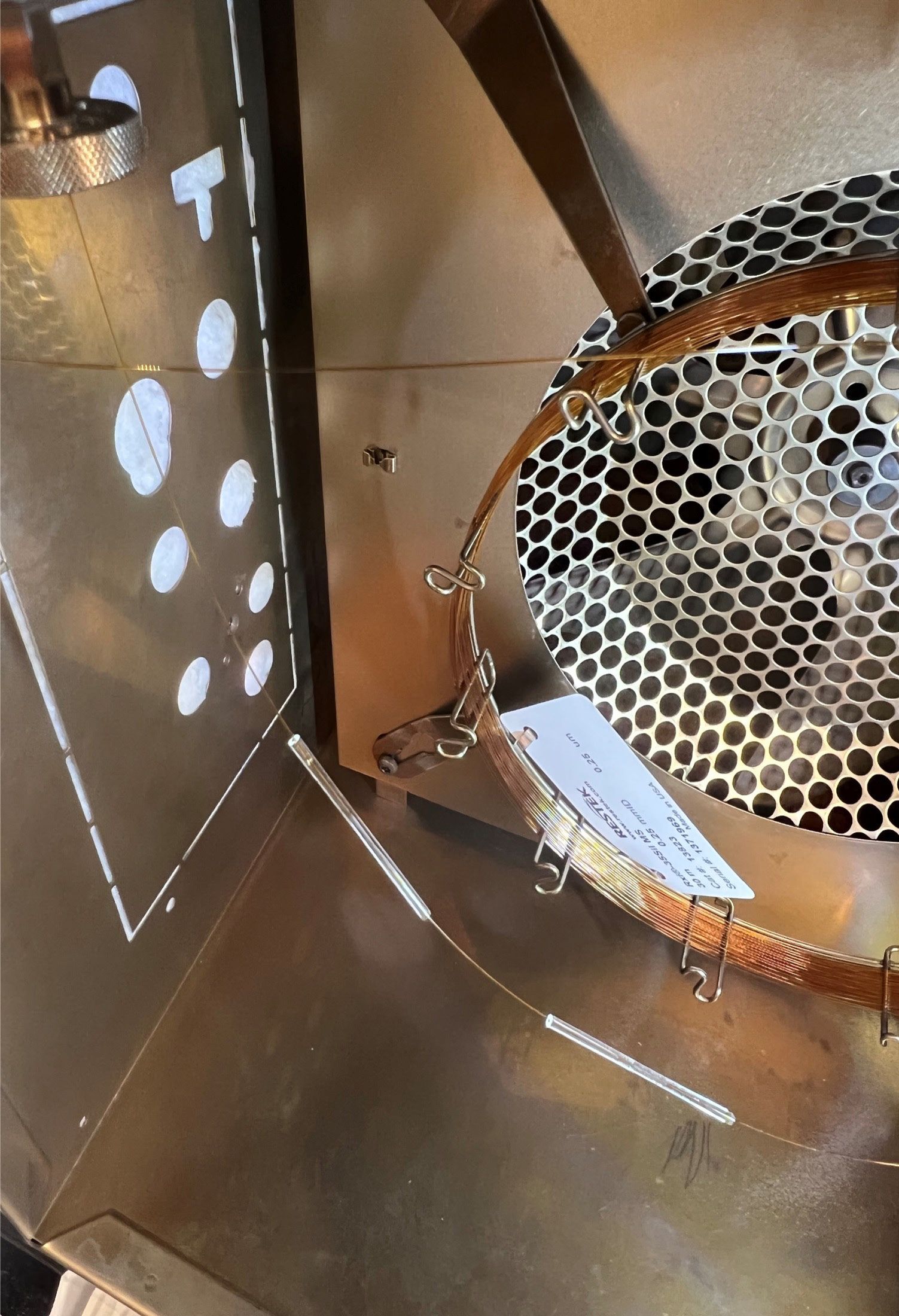
Discussion
An air and water check was performed as one method of determining a leak-free system for testing the “1-type” column where nitrogen was at 1.3% and water at 0.6%. The press-fit connector was loosened and after many attempts a small leak was created that was measured as 23% nitrogen and 4% water. The “1-type” column operated at a maximum temperature of 350 °C with a small leak, which resulted in a continually rising baseline when compared with leak‑free analysis that demonstrated a baseline drop (Figure 2). With a leak-free system, the baseline stabilized and remained flat at the maximum programmable temperature. One striking comparison can be performed by overlaying two chromatograms—one with a leak and the other leak-free using m/z 207, the base peak for hexamethylcyclotrisiloxane (D3), as shown in Figure 2.
Figure 2: “1-Type” (100% polydimethylsiloxane) stationary phase 30 m × 0.25 mm, 0.25-μm operated at maximum temperature without a leak (black trace) compared with a press-fit connector with a leak (blue trace) measured as 23% nitrogen (m/z 28) and 4% water when compared with the m/z 69 PFTBA GC–MS tuning compound. Notice the baseline rise with a leak and a baseline drop without a leak. Bleed represented by two overlaid extracted ion chromatograms using m/z 207 for the base peak of hexamethylcyclotrisiloxane (D3).

A second example was performed by overlaying two extracted ion chromatograms (EICs) for m/z 44 (carbon dioxide); as the GC–MS scan range is from 35 to 550 amu it did not detect water (m/z 18), oxygen (m/z 16), and nitrogen (m/z 28). The increased presence of carbon dioxide is another indicator of a leak in the system (Figure 3). For the addition of the “1701‑type” column and the arylene-35% diphenyl column to the experiment, two press-fit connectors were used in series where the first connector closest to the injection port was installed with a leak and the second connector allowed columns to be changed, meaning both columns could be tested with the same leak. Hours were spent creating a leak where the guard column did not disconnect at higher temperatures and the leak was not large enough to cause the inlet to shut down.
Figure 3: “1-Type” (100% polydimethylsiloxane) stationary phase 30 m × 0.25 mm, 0.25-μm operated at maximum temperature without a leak (blue trace) compared with a press-fit connector with a leak (black trace) measured as 23% nitrogen (m/z 28) and 4% water when compared with m/z 69 PFTBA GC–MS tuning compound. Since the GC–MS scan range is from 35 to 550 amu, only CO2 (m/z 44) is present in the chromatogram and not water, oxygen, and nitrogen. This rise in CO2 is another indication of a leak in the system as demonstrated in this extracted ion chromatogram (EIC).
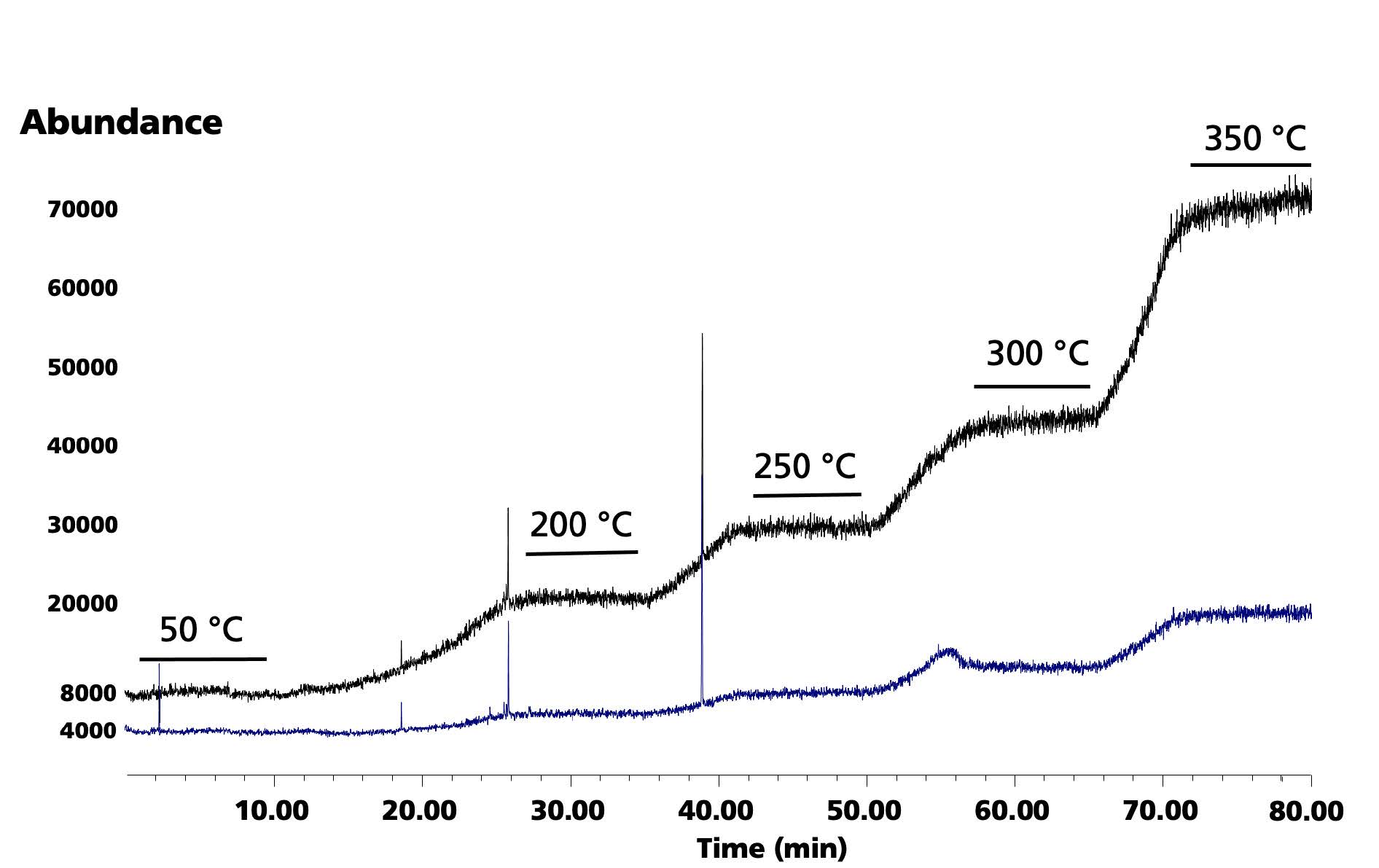
Figure 4: Overlay of total ion chromatograms (TICs) comparing three different stationary phases operated at their maximum temperatures with an air leak for a total of 180 min. “1-Type” (blue trace), “1701-Type” (red trace), and an arylene-35% diphenyl (black trace) columns were tested. The arylene-35% diphenyl phase was most resistant to oxidative breakdown.
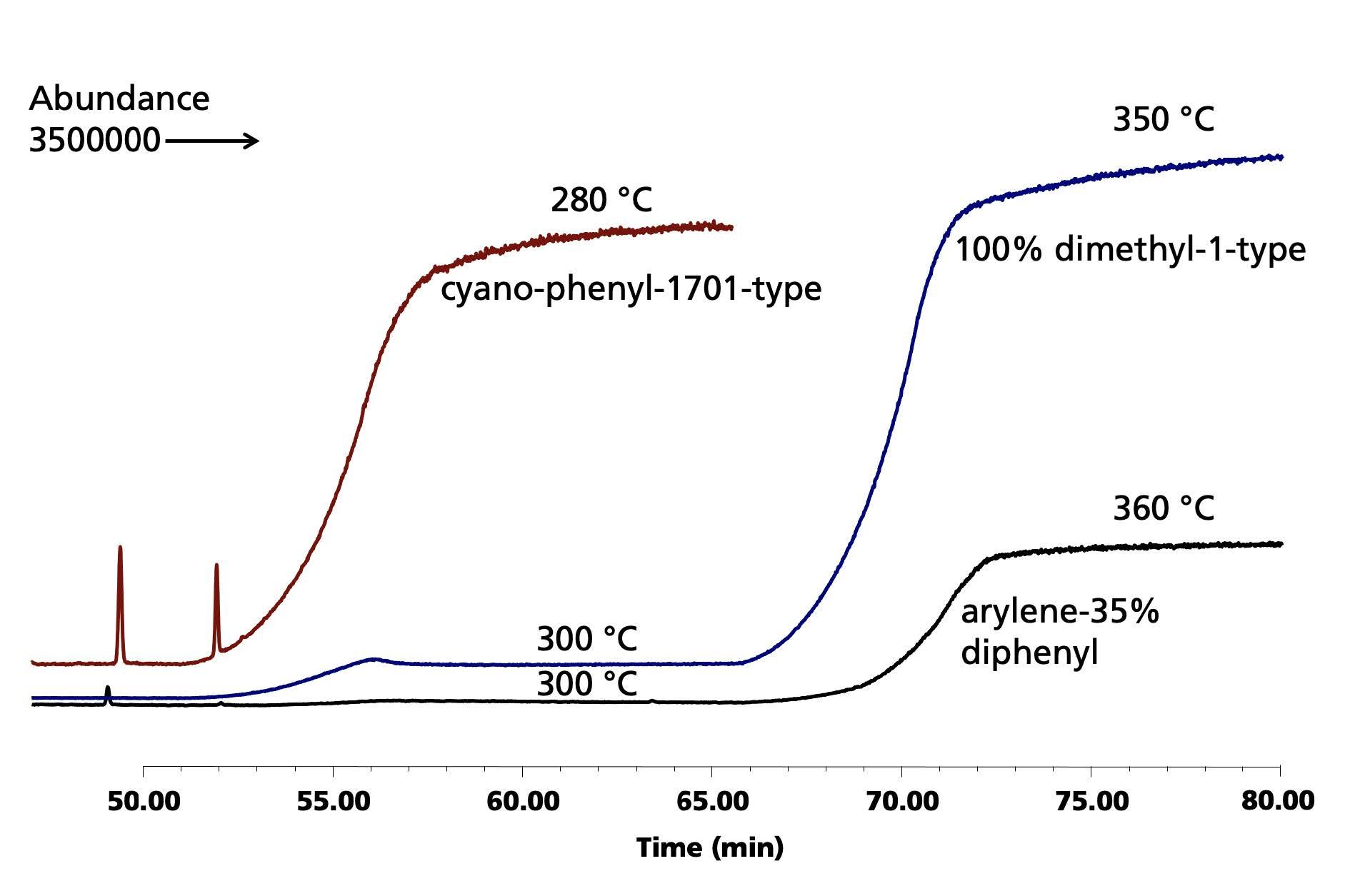
The method that worked for creating a small leak required a clean cut of the fused silica guard column followed by running the smooth side of the ceramic cutting wafer lengthwise down the column end. This created a small notch at the end of the column, yet the column was sealed in the press-fit and did not come loose at higher temperatures and pressures. The leak was measured as 19.1% nitrogen and 1.9% water at 50 °C. The “1701-type” and arylene-35% diphenyl columns were tested with five consecutive analyses of the standard without a leak followed by 18 analyses of the standard with a leak. This meant that the three columns were exposed to 180 min at their maximum temperatures and could be directly compared with each other by overlaying the total ion chromatograms (TICs). Since the bleed products were different for each of the columns, the best comparison required the use of TICs and not specific ions, as shown in previous examples. Interestingly, the “1701-type” and “1-type” columns had similar bleed profiles after exposure to oxygen for their maximum temperatures, whereas the arylene-35% diphenyl column had significantly less bleed and less of an increase at maximum temperature.
Conclusions
Small leaks may compromise column lifetime, increase maintenance, cause retention time shifts, and decrease sensitivity at elevated temperatures. Both the “1701-type” and “1-type” columns exhibited high bleed at their maximum temperatures but similar bleed at lower temperatures, such as 200 °C. The arylene stabilized polymer showed the best resistance to oxidative breakdown and exposure to water at elevated temperatures.
Acknowledgements
Special thanks to Jaap de Zeeuw and Erica Pack (Restek) for their technical advice and review.
References
- C. English, The Column 18(10), 11–15 (2022).
- C. Poole, Ed., Gas Chromatography (Elsevier, 2nd Ed., Amsterdam, The Netherlands, 2020), pp. 21, section 1.4.5.
Chris English has managed a team of chemists in Restek’s innovations laboratory since 2004. Before taking the reins of the laboratory, he spent seven years as an environmental chemist and was critical to the development of Restek’s current line of volatile GC columns. Prior to joining Restek, he operated a variety of gas chromatographic detectors conducting method development and sample analysis. Chris holds a B.S. in environmental science from Saint Michael’s College, USA.
E-mail: chris.english@restek.com
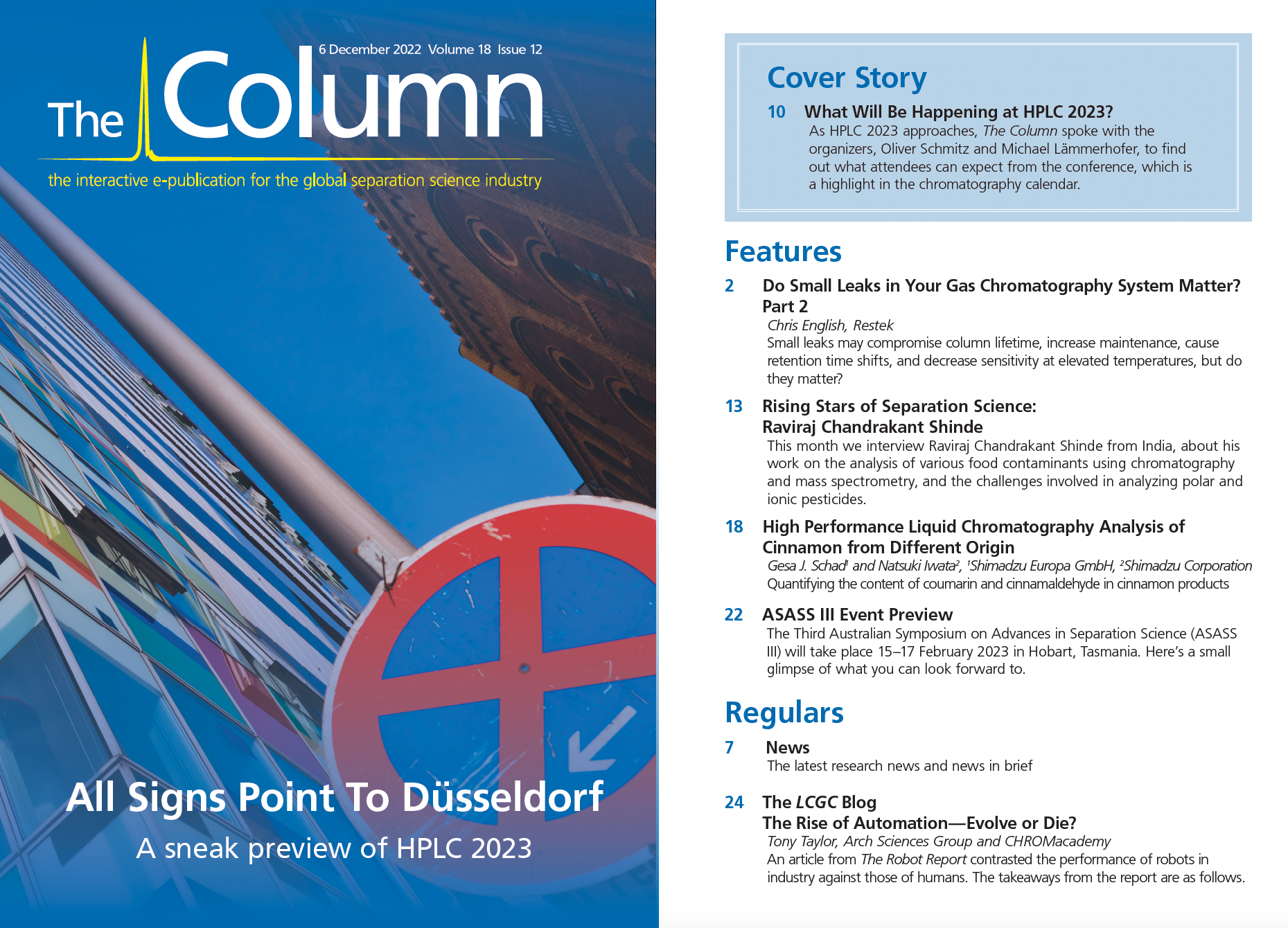
New Study Reviews Chromatography Methods for Flavonoid Analysis
April 21st 2025Flavonoids are widely used metabolites that carry out various functions in different industries, such as food and cosmetics. Detecting, separating, and quantifying them in fruit species can be a complicated process.
University of Rouen-Normandy Scientists Explore Eco-Friendly Sampling Approach for GC-HRMS
April 17th 2025Root exudates—substances secreted by living plant roots—are challenging to sample, as they are typically extracted using artificial devices and can vary widely in both quantity and composition across plant species.

.png&w=3840&q=75)

.png&w=3840&q=75)



.png&w=3840&q=75)



.png&w=3840&q=75)










